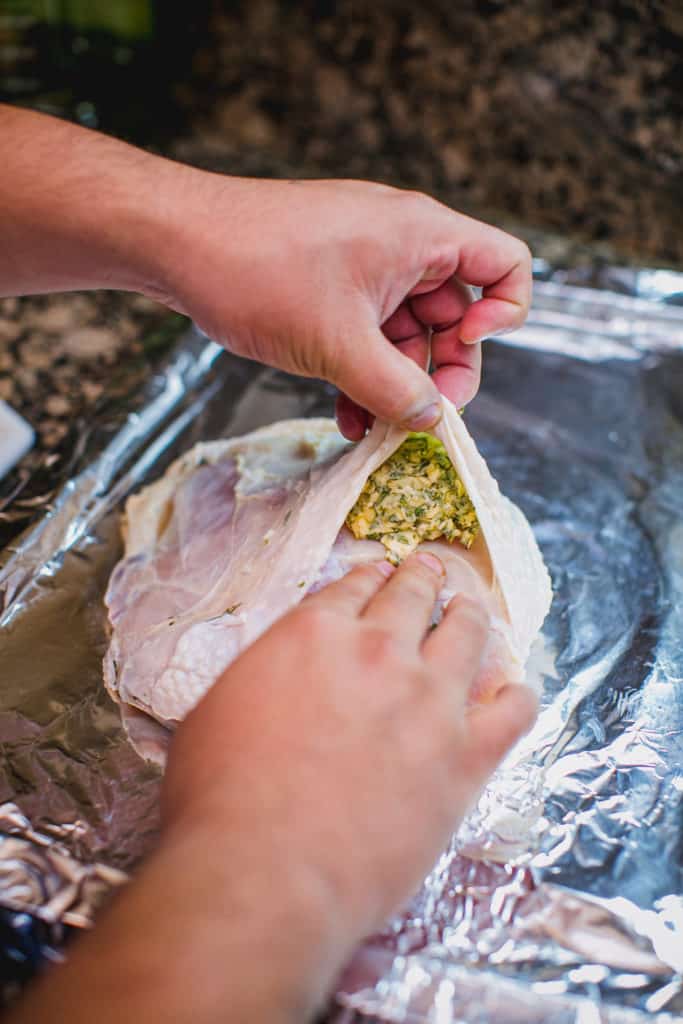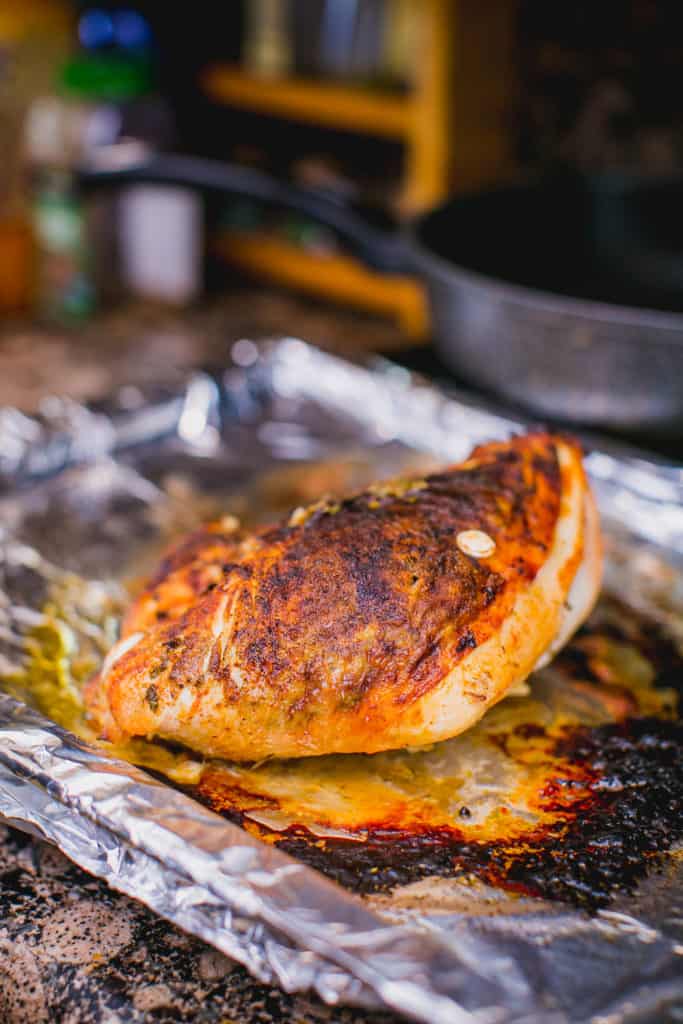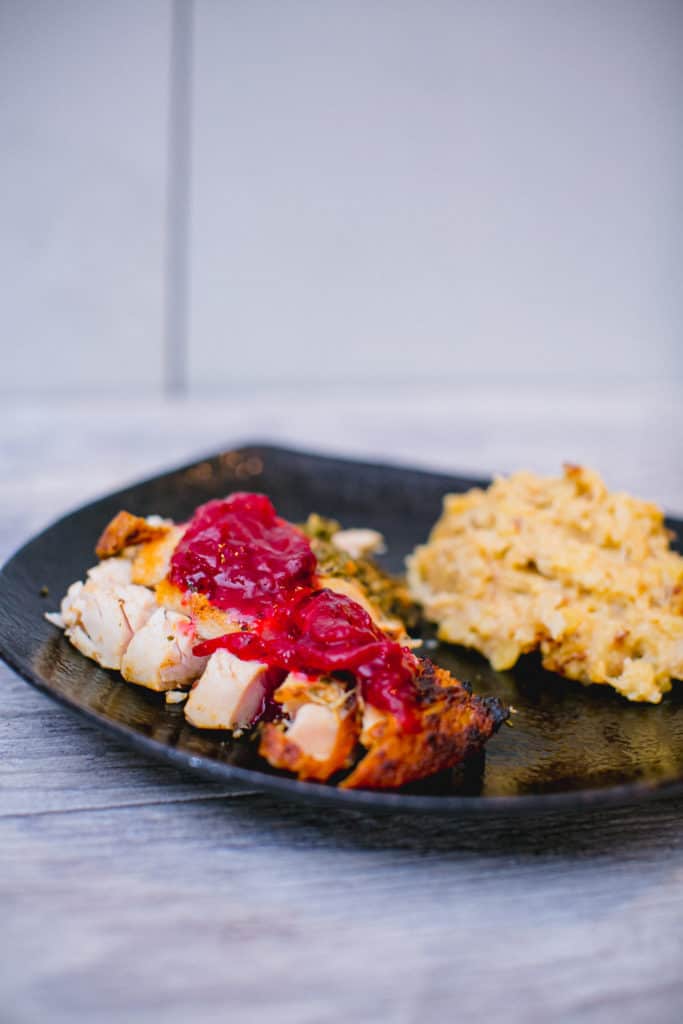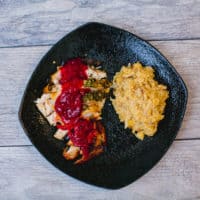As an Amazon Associate we earn from qualifying purchases.
I always thought it was very strange that I eat turkey sandwiches all year long, but when it comes to oven roasting a turkey, I reserve this for once a year on Thanksgiving. That said, I am a pretty firm believer in roast turkey year round.
Ask a group of people what the best part of Thanksgiving is and they will likely tell you it’s the turkey. Second to turkey, it might be leftovers – which is really just turkey again for sandwiches. Either way, you shouldn’t have to wait until November to enjoy delicious oven roast turkey.

Quick Navigation
What is an Oven Roasted Turkey Breast?
An oven roasted turkey breast is cooked in an oven. The turkey will often be brined and seasoned prior to cooking. Oven roasted turkey can be served as a main course or sliced into sandwiches or salads.
Why is Turkey so Dry?
Cooked turkey gets dry for two reasons:
- Muscle fibers called myosin in the turkey constrict when heat is applied. This reduces the volume of the meat and forces water out.
- Turkey is a fairly lean meat, which means there is not that much fat dispersed through the muscle fibers. The rendered fat in meat is what helps keep it moist. Think of the best steaks you’ve seen in the market with all the fat marbled through the meat – turkey has none of that.
How Do I Keep My Turkey from Drying Out?
To keep your turkey from drying out, you need to address the two main culprits to dry turkey: the myosin fibers constricting water out of the meat and the lack of fat in turkey.
To mitigate the physical effects of myosin squeezing water out of your bird, I am going to use salt. Salt will break down those muscle fibers, making them too weak and lose to force the juice out of your bird.
To address the low fat issue, I’m going to add my own fat in the form of butter. What is important here is where you add the fat. I do not want the fat to be on the outside of the skin. If you do this, it will just brown and fall off, never coming into contact with my meat.

When I add the butter I am going to disperse it under the skin, in direct contact with the meat. This allows both a better conduction of heat with the meat, as well as keeping the oils in contact with the meat. Overall, this gives me the rich mouthfeel I want.
Finally, by seasoning my butter, I get better distribution of fat soluble flavors into my bird. The butter will act as a transport of flavor for things like spices or aromatics.
What Temperature is Turkey Done at?
You have probably heard and seen that 165°F for poultry like turkey is the target temperature. I recommend 150-155°F. Afraid of salmonella? You shouldn’t be at this temperature! 165°F is the temperature for flash pasteurization, which basically kills all the baddies in 10 seconds or less. Now, since no one I know has ever cooked a turkey in 10 seconds or less, it obviously stands that you could cook it to a lower temperature.
So, why 150°F? 150°F is the temperature where the myosin starts really constricting and forcing juice out. So, if I stop the cook at 150°F, even my weakened muscle fibers won’t be putting up much of a fight.
Still worried about salmonella? At 150°F, it takes 3.8 minutes to pasteurize your food. This means if the coldest part of your turkey was 150°F, you could add about 4 minutes of cook time. You could also just take the turkey out at 150°F and let the carry over heat cook it through.
To put this in perspective, when you sous vide poultry, you can safely cook at 145°F for about 1-1.5 hours to achieve the same level of food safety.
All this goes to say, don’t skimp on a good meat thermometer. Even pros aren’t eyeballing multiple points of doneness to a 10th of a degree of accuracy!

My Approach to Oven Roast Turkey Breast
My approach when making turkey in the oven is just like I do at Thanksgiving – brine it! The brine I’ll be using in this recipe is on the stronger side. You can brine the turkey for 2-24 hours, but I wouldn’t go any further than that or you will have some pretty salty meat.
What is a Brine?
A brine is a salt and water based solution that meat is placed into. You may recall from your middle school science class that water moves from areas of high concentration to low via a process called osmosis.
In food terms, this is critical because it means that normal water will leave turkey and it will gradually be replaced with my flavored water as it reaches equilibrium.
Why do I Brine a Turkey Breast?
I brine a turkey to do a couple things:
- It adds flavor to the meat by bringing salt in
- It helps break down muscle fibers which keep your turkey juicy as it cooks
Do You Have to Brine Your Turkey?
You don’t need to brine your turkey, but I highly recommend it. As an alternative, you can also dry salt your turkey overnight in the fridge. This can help accomplish the same muscle breakdown, though it will not be as uniformly flavored with a more cured outside rim.

What Pairs With Oven Roasted Turkey?
It’s hard to beat cranberry sauce or gravy when it comes to turkey pairings. For sides, stuffing, biscuits, and potatoes are a welcome add on as well. Add a delicious spiced drink to this, and you can enjoy Thanksgiving all year round!
Tools Required
For a single turkey breast you need the following tools:
- Pot that can hold around 6 cups of liquid
- Measuring cups
- Large freezer Ziploc bag
- Baking sheet
As you can see, I am keeping my tools simple!

Ingredients
Turkey
- 1 bone in turkey breast (no wings – size may vary; over here they are about 3 pounds. Note, this is not a double breast it is one side only)
Brine
- 1/2 cup salt
- 1/2 cup sugar
- 4 cup water
Butter Mixture
- 2 tablespoons butter
- 1 tablespoon finely chopped rosemary
- 1 tablespoon finely chopped sage
Seasoning
- Salt, pepper, paprika to taste
Instructions
Make the brine
- Bring water to a boil and turn off the stove
- Add sugar and salt and stir until dissolved
- Set aside and let cool to room temperature
Brine the turkey
- Fill large Ziploc freezer bag with room temperature brine solution
- Add turkey breast to bag, place the bag in a large bowl incase it leaks, and place in fridge for 2-24 hours
Make the butter mixture
- Wash and cut herbs so they are finely chopped
- Mix together with butter (you can microwave the butter for a few seconds if you need to soften it)
Cook the turkey
- Preheat oven to 450°F
- Remove turkey from bag, place on a baking sheet, and pat dry with paper towels
Separate skin from breast and fill with butter, spreading evenly - Bake for 20 minutes or until skin is golden brown
- Reduce heat to 350°F and continue baking until internal temperature reads 150°F. This will be about 40 minutes, depending on the size of your turkey breast
- Slice the turkey as desired and serve
